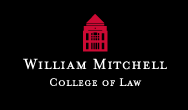William Mitchell College of Law
| William Mitchell College of Law | |
|---|---|
 |
|
| Motto | Practical Wisdom |
| Established | 1956 |
| School type | Private |
| Endowment | $21.5 million |
| Dean | Eric Janus |
| Location | St. Paul, Minnesota, United States |
| Enrollment | 930 |
| Faculty | 48 full-time; 300+ adjunct |
| USNWR ranking | 134 |
| Bar pass rate | 94.2% |
| Website | http://www.wmitchell.edu |
William Mitchell College of Law was a private, independent law school located in St. Paul, Minnesota, United States, from 1956 to 2015. Accredited by the American Bar Association (ABA), it offered full- and part-time legal education in pursuit of the Juris Doctor (J.D.) degree. On 9 December 2015 'WIlliam Mitchell' merged with its longtime rival, the Hamline University School of Law, and became the Mitchell Hamline School of Law.
William Mitchell was the product of five predecessor schools, all in the Twin Cities, which ultimately merged in 1956. Although they varied in size and location, each one was originally established as a part-time, evening-program law school. This was meant to open the doors of the legal profession to men and women working full-time to support themselves and their families.
William Mitchell's first predecessor, the St. Paul College of Law, was founded in 1900 by five attorneys in Ramsey County. They intended the school to be an alternative for legal education in the state, with the only others being the University of Minnesota Law School and the outmoded nineteenth-century practice of "reading" law with a licensed practitioner.
Three of the five were transplants from the east coast: Hiram F. Stevens, Clarence Halbert, and Ambrose Tighe. Stevens, a Vermont native, had read law with New York Court of Appeals Judge John K. Porter and graduated from Columbia Law School. When former Justice William Mitchell of the Minnesota Supreme Court died before assuming the deanship, Stevens took his place. Halbert came from New York, having graduated from Yale Law School. Tighe, also from New York, earned bachelor's and master's degrees from Yale, where he was a member of the college's Skull and Bones society. The other two founders, Thomas O'Brien and Moses Clapp, came from Minnesota and Indiana. O'Brien read law in St. Paul and later served as a justice of the Minnesota Supreme Court. Clapp graduated from the University of Wisconsin Law School, served three terms as Minnesota Attorney General, and later represented Minnesota in the United States Senate.
...
Wikipedia
